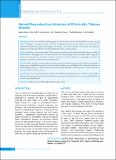Please use this identifier to cite or link to this item:
https://hdl.handle.net/20.500.14356/1202Full metadata record
| DC Field | Value | Language |
|---|---|---|
| dc.contributor.author | Sarna, Kaylee | - |
| dc.contributor.author | Cioffi, Gino | - |
| dc.contributor.author | Craig, Sienna | - |
| dc.contributor.author | Sloan, Jill Barnholtz | - |
| dc.contributor.author | Basnyat, Buddha | - |
| dc.contributor.author | Beall, Cynthia | - |
| dc.date.accessioned | 2023-05-02T09:57:18Z | - |
| dc.date.available | 2023-05-02T09:57:18Z | - |
| dc.date.issued | 2021 | - |
| dc.identifier.citation | SarnaK., CioffiG., CraigS., Barnholtz-SloanJ., BasnyatB., & BeallC. (2022). Varied Reproductive Histories of Ethnically Tibetan Women. Journal of Nepal Health Research Council, 19(04), 748-753. https://doi.org/10.33314/jnhrc.v19i04.3273 | en_US |
| dc.identifier.issn | Print ISSN: 1727-5482; Online ISSN: 1999-6217 | - |
| dc.identifier.uri | http://103.69.126.140:8080/handle/20.500.14356/1202 | - |
| dc.description | Original Article | en_US |
| dc.description.abstract | Abstract Background: The U.N. health and well-being goals for 2030 focus on maternal and child health outcomes, among others. Challenges to meeting those goals vary widely throughout Nepal owing to the range of sociocultural factors, infrastructural limitations, physical geography and altitudes. This article explores sociocultural and biological influences on fertility and child survival among ethnically Tibetan women in Nepal. Methods: This is a cross sectional study of 430 women, age 46-86 years old, citizens of Nepal and native residents above 3500m in Mustang District, who provided interview and physiological data. Univariate Poisson regression analyses selected significant variables to include in multivariate Poisson regressions investigating the number of pregnancies, livebirths, child survival and death outcomes. Results: Earlier age at first pregnancy, later age at last pregnancy, and miscarriages associated with more pregnancies. Miscarriages and stillbirths associated with fewer livebirths. Higher maternal BMI and FEV6 associated with fewer children dying before age 15. Marital characteristics (status, type, continuity), contraceptive use, relative wealth, and education influenced these covariates. Conclusions: Low maternal pulmonary function and nutritional status predict poorer child survival in Upper Mustang. Addressing poor lung function and nutrition may improve reproductive outcomes among ethnically Tibetan women living at high altitude. Keywords: Child survival; fertility; high-altitude; Nepal; women | en_US |
| dc.language.iso | en | en_US |
| dc.publisher | Nepal Health Research Council | en_US |
| dc.relation.ispartofseries | Oct-Dec, 2021;3273 | - |
| dc.subject | Child survival | en_US |
| dc.subject | fertility | en_US |
| dc.subject | high-altitude | en_US |
| dc.subject | Nepal | en_US |
| dc.subject | women | en_US |
| dc.title | Varied Reproductive Histories of Ethnically Tibetan Women | en_US |
| dc.type | Journal Article | en_US |
| local.journal.category | Original Article | - |
| Appears in Collections: | Vol. 19 No. 04 (2021): Vol 19 No 4 Issue 53 Oct-Dec 2021 | |
Files in This Item:
| File | Description | Size | Format | |
|---|---|---|---|---|
| 3273-Manuscript-26784-1-10-20220313.pdf | Fulltext Download | 626.61 kB | Adobe PDF |  View/Open |
Items in DSpace are protected by copyright, with all rights reserved, unless otherwise indicated.
